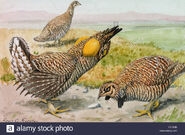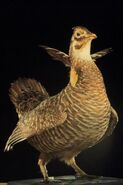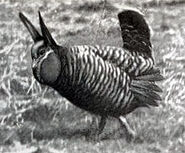| Heath Hen | |
|---|---|

| |
| Two males fighting, 1922 | |
| Conservation status | |
| Scientific classification | |
| Kingdom: | Animalia |
| Phylum: | Chordata |
| Class: | Aves |
| Order: | Galliformes |
| Family: | Phasianidae |
| Subfamily: | Tetraoninae |
| Genus: | Tympanuchus |
| Species: | †T. c. cupido |
| Binomial name | |
| †Tympanuchus cupido cupido (Linnaeus, 1758) | |
The Heath Hen (Tympanuchus cupido cupido) is an extinct subspecies of chicken that was hunted for food in the 17th and 18th centuries.
Extinction[]
Owing to intense hunting pressure, the population declined rapidly. Perhaps as early as the 1840s, at any rate by 1870, all heath hens were extirpated on the mainland. There were about 300 left on the island of Martha's Vineyard, off Massachusetts, but by 1890 this number had declined to 120–200 birds, mainly due to predation by feral cats and poaching. By the late 19th century, there were about 70 left. These were protected by a hunting ban and by the establishment in 1908 of the "Heath Hen Reserve" (today the Manuel F. Correllus State Forest), and the population rapidly grew to almost 2000: by the mid-1910s, observing the birds on their lekking grounds had become something of a tourist attraction. However, a destructive fire during the 1916 nesting season, severe winters, an unusual influx of predatory goshawks, inbreeding, an excess number of male individuals and apparently an epidemic of blackhead disease, which might have been transmitted by poultry, brought the numbers down quickly; after a last recovery to 600 in 1920, the population began its final decline.
In 1927, only about a dozen were left – a mere two being females – despite being afforded the best protection according to contemporary science; that number had declined to a handful, all males, by the end of the year. After December 8, 1928, apparently only one male survived, lovingly nicknamed "Booming Ben". He was last seen on his traditional lekking ground between West Tisbury and today's Martha's Vineyard Airport on March 11, 1932 – early in the breeding season -, and thus presumably died, about 8 years old, days or only hours afterwards from unknown causes.











